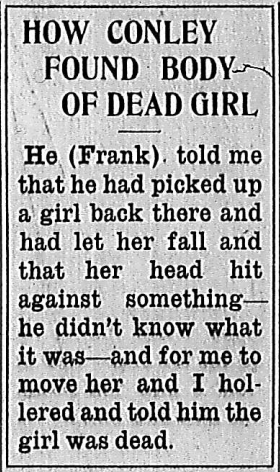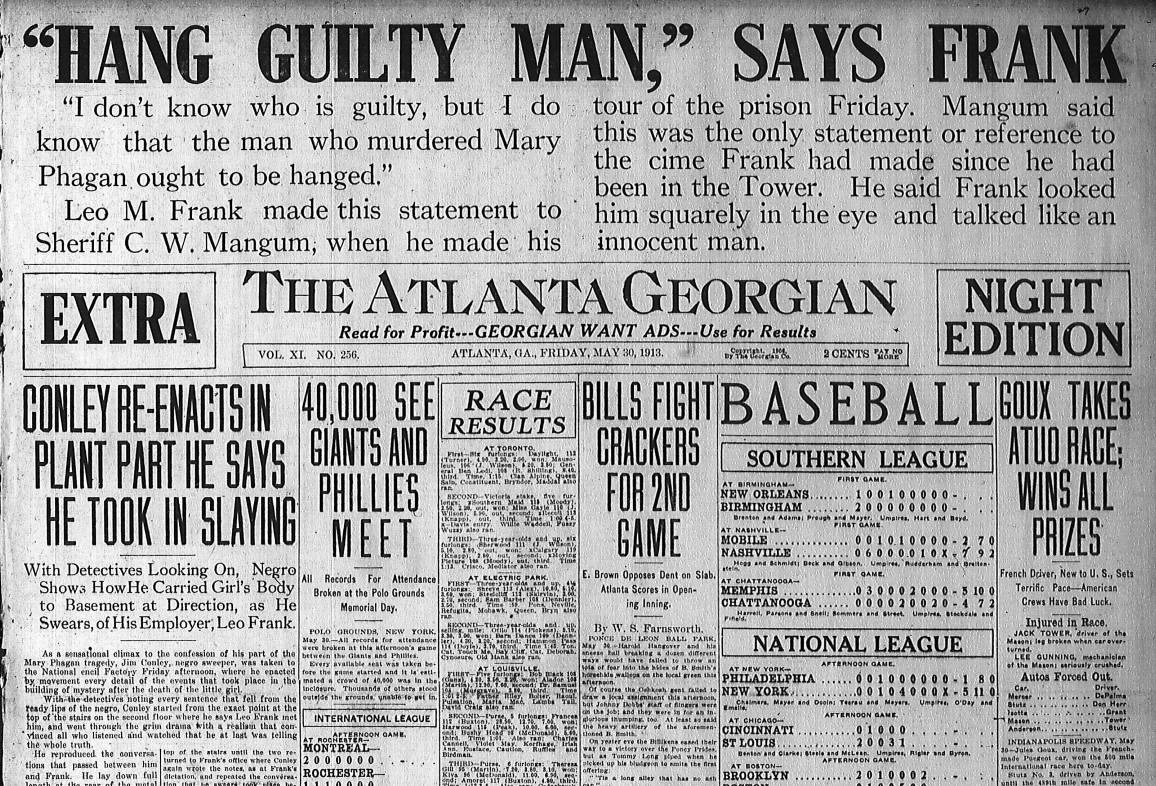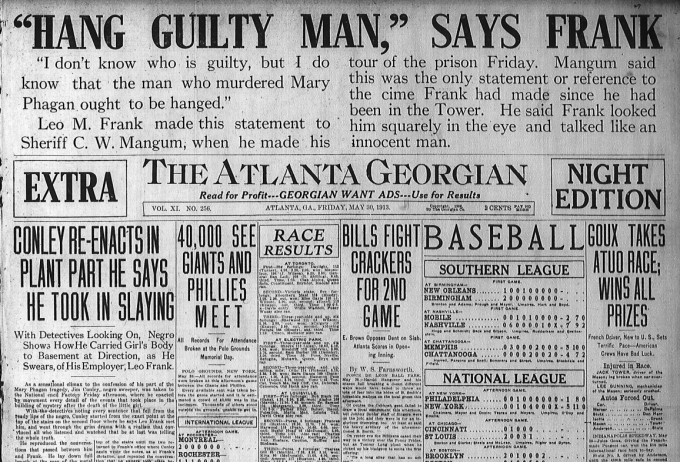Another in our series of new transcriptions of contemporary articles on the Leo Frank case.
Atlanta Georgian
Thursday, May 29th, 1913
With Detectives Looking On, Negro Shows How He Carried Girl’s Body to Basement at Direction, as He Swear, of His Employer, Leo Frank.
As a sensational climax to the confession of his part of the Mary Phagan tragedy, Jim Conley, negro sweeper, was taken to the National [P]encil Factory Friday afternoon, where he enacted by movement every detail of the event that took place in the building of mystery after the death of the little girl.
With the detectives noting every sentence that fell from the ready lips of the negro, Conley started from the exact point at the top of the stairs on the second floor where he says Leo Frank met him, and went through the grim drama with a realism that convinced all who listened and watched that he at last was telling the whole truth.
He reproduced the conversations that passed between him and Frank. He lay down full length at the rear of the metal room to show precisely how the body of the little girl lay when he first saw it. He lay partly on his face, with his right leg slightly drawn up, to portray the position of the dead girl when he first saw her as he was led to the rear of the building, as he says, by Leo Frank.
Show How Body Laid.
Later in the basement he lay down again to show the detectives just how the body was dropped to the ground as though it had been a sack of salt. The negro lay on his face. His right arm was curled up under his body. The left arm was partly under his body, but straight. His feet pointed toward the rear door and his head toward the front of the building.
The announcement that this spectacular reproduction of the crime was to take place was made at the end of another third degree session in the office of Chief Lanford. The negro was put in Chief Beavers’ automobile. All the curtains were drawn and the utmost secrecy was maintained. Only those in authority in the factory were aware that the tragedy was to be re-enacted, step by step.
Conley was handcuffed to Chief Beavers when he stepped from the car. Many of the employees, at leisure during the noon hour, were congregated at the foot of the stairs on the first floor when the strange procession filed up the stairs. The city detectives had come on foot. Chief Lanford and Chief Beavers, with the negro, arrived a few minutes later.
Some of the employees, curious to learn the latest development in the mystery, attempted to follow. They were turned back with orders not to come inside and the doors were barred against them. Guided by the negro, Herbert Schiff and E. F. Holloway, the party of detectives and newspaper men started on the tour which was to reproduce the tragedy, detail by detail, from the moment Conley declares that he met Frank at the top of the stairs until the two returned to Frank’s office where Conley again wrote the notes, as at Frank’s dictation, and repeated the conversation that he swears took place between them.
Besides Chief Beavers and Chief Lanford, there were in the party Detective Harry Scott, of the Pinkertons, and City Detectives Coker and Campbell.
“Where did you first see Frank when he whistled to you twice?” Conley was asked as soon as he had reached the second floor.
Details Every Move.
“Right here,” he replied to the negro, pointing to the top of the steps.
From this point the negro went on detailing every movement and every fragment of conversation that he remembered until he left the building.
 “He asked me if I wanted to make some money right quick and I told him I did,” said Conley. “Then he said he had picked up a girl back there who had hit her head against something and he wanted me to bring her body to the elevator.”
“He asked me if I wanted to make some money right quick and I told him I did,” said Conley. “Then he said he had picked up a girl back there who had hit her head against something and he wanted me to bring her body to the elevator.”
The negro at this point walked back toward the rear of the second floor, all of the officers following him. He pointed out to the officers the exact point where he had found the body, lying partly doubled up near the men’s toilet.
“When I got back here, I got scared and hollered to Mr. Frank and said that the girl was dead,” the negro continued. “He was standing in that doorway right there. He told me to get a sack and put her body in that.”
The dozen men in the party, gripped by the realistic reproduction of the tragedy, followed Conley as he walked to a cotton box in the middle of the second floor and picked out a sack of cotton bagging.
Tells of Seeing Cord.
“This is jus’ like that I got that day except that this has got a little more cotton in it and the other one was slit,” said the negro, holding the bagging up for the inspection of the officers.
“I went back and raised her up and slipped the bagging under her like this,” said the negro, illustrating. “Then I raised her head and shoulders and pulled the bagging up so that I could put it over my shoulder.”
Here the negro told for the first time of seeing the cord which was used in the strangling of the little girl.
“The cord was lying right there,” said Conley. “It was right by the body, but I didn’t notice that it was around her neck. I didn’t think that it might have been used to strangle her.”
Conley then pointed out the spot where he said that the girl’s weight became too heavy for him and he called on Frank to help him. Frank, he said, came cursing from the doorway.
“He picked up her feet,” said Conley, “and I carried her shoulders. Just when we got by this window Frank was so nervous that he dropped the girl and her feet dragged on the floor.” It was at this place that a splotch of blood was found by the detectives.
Conley then walked toward the elevator, talking all the time of what was occurring on that other time he had made the same trip through the building. The negro appeared to be telling a straightforward story and was ready with an answer whenever an of the officers asked him a question.
As Conley and the detectives reached the elevator, the negro said that he waited there while Frank went into the office to get the key to the elevator door. He described the manner in which the body was carried into the elevator and dropped on the elevator floor. Frank ran the elevator down to the basement, according to Conley, while he (Conley) ran it on the return upstairs. Conley went down on the elevator just as he had done before, the officers with him.
“I took her body out of the elevator,” said Conley, “and Mr. Frank helped me. He told me to take the body up to the trash pile in front of the furnace. I put the girl on my shoulders again and walked up there with her and dropped her right there,” pointing to a point only a few feet to the left of the furnace.
“I pulled the bagging out from under her and threw it there on the pile of trash in front of the furnace. Mr. Frank he waited there at the trap door to see if anyone was coming. Before that I went back upstairs and got her hat and shoes and brought them down in the basement.”
“Show us the way you left the girl’s body,” commanded Chief Beavers.
Conley promptly lay down in the identical spot where Newt Lee found the body of the girl. He lay with the left side of his face on the ground, his right arm slightly under him and the left arm stretched by his side. His feet pointed toward the rear door of the basement where the staple was pulled.
Negro Never Hesitates.
“You can’t help but believe him,” muttered Detective Harry Scott, as the negro went through the terrible tragedy movement by movement without faltering for an instant or hesitating as though he were not sure of his ground.
Conley appeared perfectly composed as though he were reciting an everyday occurrence, but his earnest and apparently truthful bearing gave his dramatic story, told in a matter of fact way, a convincing power that evidently had its effect on every one who was listening to his recital.
Negro Ran Elevator Up.
“Did you ever find that piece of cotton bagging?” Chief Beavers inquired of E. F. Holloway, the day watchman.
“No, I never did,” Holloway replied, his answer leading to the presumption that the bagging subsequently had been burned.
After showing the detectives where he had disposed of the body, Conley retraced his steps toward the elevator.
“Frank climbed up this ladder,” he said, “and I rand the elevator back up. He met me on the first floor and got in the elevator with me and rode with me up to the second floor.”
Conley ran the elevator back up as he had done the day of the tragedy. Chief Beavers and several of the detectives rode up with him. Chief Lanford climbed up the ladder as Frank was represented as doing. Conley said that Frank was nervous and rushed off the elevator before it had come to a stop, stumbling in his haste.
Illustrates Fall.
Having the elevator stopped about a foot and a half below the landing, Conley illustrated the fall of Frank, who in his hurry to get out of the elevator stumbled and fell on his hands, the negro says. Getting up from the floor, Conley led the officers to the sink where the negro claims Frank washed his hands. Conley says he waited for Frank by a post near the elevator landing. When Frank came from washing his hands, Conley said, he led him (Conley) into the office and had him sit down. Conley said Frank kept twisting about in his chair, wringing his hands, and “acting lak white folks does when they is scared, turned red in the face, and kept looking around.”
Conley said Frank next walked out of the room and got a box of matches, stopped in the door and fooled with a cigarette box. He says Frank then looked out the glass door and said: “Oh, God, here comes Emma Clark and Corinthia Hall,” and quickly pushed him in the closet at the side of the door, closing the closet door.
Put Him in the Closet.
The officers put Conley in the closet. It easily held him. Conley said he could not tell whether or not the girls entered the room. He heard one of them ask, “Are you all alone, Mr. Frank?” and Frank answered, “Yes, I am alone.”
Pretty soon Frank came and let Conley out, Conley says, and had him sit down at Frank’s desk. Conley says Frank got some paper from a drawer and told him to write a note. The officers had Conley sit down and write what he claims Frank dictated to him. Conley readily wrote, “Dear mother a long tall black negro did this by hissleb he told me if I would lay down he would love me play like the night wich did this by hisselb.”
How About Me?
Conley says he asked Frank what he was going to do with the note. Frank replied that he was going to put it in a letter and send it to his mother in Brooklyn, that he had wealthy people there. Conley says Frank then clasped his hands, looked at the ceiling and exclaimed, “Why should I hang?”
“I asked him,” Conley told the officers, “what about me?” Frank says, “Don’t you worry, you are a good boy and you will be all right.”
The negro stated that Frank then handed him a roll of greenback money and said it was $200. Conley says he did not count it, and that Frank suddenly grabbed it away from him, telling him that his people in Brooklyn would send him plenty of money and he would give Conley plenty of money later.
Frank next took a cigarette, Conley declared, and then asked him to have one, handing him the box. Conley says he saw a little money in the box and was afraid to let Frank see it, for fear he would take it away from him. Conley next illustrated the manner in which he says Frank walked to the stairs with him. The negro says Frank placed his arms around his shoulders and walked to the stairs with him, and watched him descend. Then Frank ran about five steps down and looked to see if Conley went on out.
Of His Own Free Will.
While in the superintendent’s office Conley stated that he was making this confession of his own free will and accord; that the officers had never in any way mistreated him or cursed him or struck him, and that they had not offered him any reward in order to induce him to tell what he knew. He explained his delay in making his confession by saying that the had been hoping to receive a large sum of money from Frank’s people. He said that he had thought Frank would get out and then help him out, but he now saw that there was no hope for either of them, and he had decided to tell the truth. Conley stated that the people at the factory seemed to be down on him, but that he wanted to tell all he knew and had done so.
After Conley had finished illustrating his part in the crime he was led back to the second floor and then was taken back down to the basement in the elevator. On the way down Chief Beavers remarked to him:
“This must be familiar scenery to you, Jim.” The negro smiled and replied: “It sure is, boss.”
Conley did not hesitate for a moment during the entire time he was showing his part in the crime, and his frankness of speech and clocklike word impressed the officers that he was last telling the exact truth.
“There is not a doubt that he negro is telling the truth and it would be foolish to doubt it. The negro couldn’t go through the actions like he did unless he had done this just like he said,” said Harry Scott.
“We believe that we have at last gotten to the bottom of the Phagan mystery. Conley’s confession fits exactly with our theory.”
Going out the rear door of the basement, the officers hurried Conley into Chief Beavers’ automobile and took him back to the police station.
A large crowd had gathered in front of the pencil factory and at the rear, bu there was no marked demonstration against him. Most of these were factory employees who have been of the belief that Frank is innocent and that the negro has been shifting the responsibility from his own shoulders to those of an innocent man.
There was some muttering of, “There’s the negro now; get him,” but there was no concerted demonstration. The automobile was driven rapidly away.
Detective Harry Scott stated to a Georgian reporter that there would be very little more questioning of the negro. He said that there could be very little more to tell, and that it was his opinion that Conley had told practically everything he knew.
Chief Beavers and Chief Scott, after the dramatic story of the negro, were of the same opinion. They said that Conley had proved to their satisfaction the guilt of Frank and that they could no longer hold any doubt of it.
* * *
Atlanta Georgian, May 29th 1913, “Conley Re-enacts in Plant Part He Says He Took in Slaying,” Leo Frank case newspaper article series (Original PDF)

